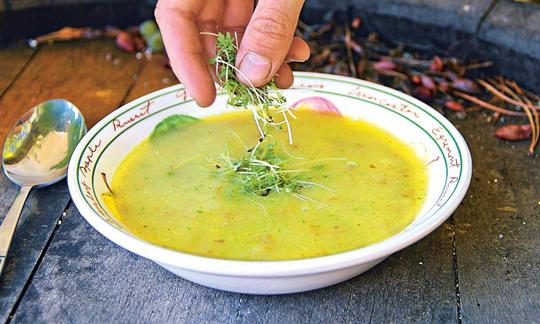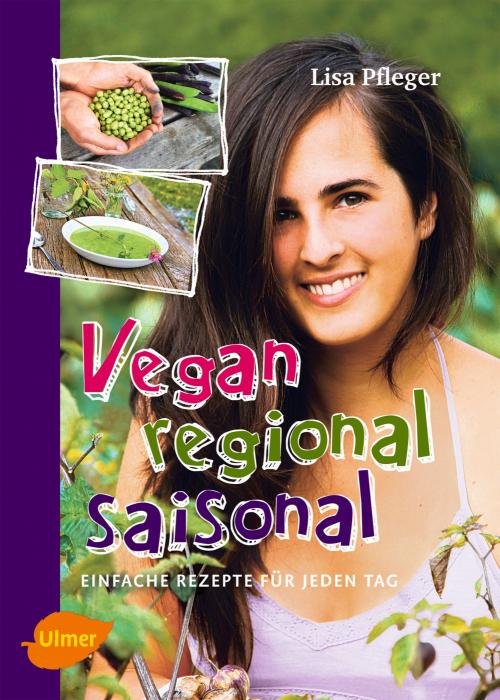Cress Soup with Potatoes and Garden Cress
vegan
Ingredients (for servings, )
| For the cress soup | |
|---|---|
| 4 | Russet potatoes, raw (organic?) (13 oz) |
| 1 | Onions, raw (organic?) (3.9 oz) |
| 1 tsp | Sunflower oil (cold pressed? raw? organic?) (0.16 oz) |
| 600 ml | Drinking water, raw (organic?) (21 oz) |
| 2 ⅔ oz | Garden cress, raw (organic?) |
| Seasoning and serving | |
| 1 dash | Table salt (table salt, raw?, organic?) (0.01 oz) |
| ⅞ oz | Garden cress, raw (organic?) |
Equipment
- hand-held blender / immersion blender or blender
- stove
- saucepan
Type of preparation
- cook
- chop or grind
- sweat
- season to taste
- purée
Preparation
For the cress soup
Chop the potatoes and onion and sweat in some hot oil in a saucepan.The author uses medium-size waxy potatoes for this recipe.
Pour the water (≈ 4 cups for 2 servings) on top of the potatoes and onions and let cook for 15 minutes, or until tender.
You can use a little less water at first and then add more later to achieve the desired consistency.
Add the fresh garden cress to the soup and purée.
The original recipe calls for 2 bowls of cress. To be on the safe side, use a little less at the beginning as cress sometimes tastes quite spicy. If you think there isn’t enough cress in the soup, you can always add more.
Seasoning and serving
Season with salt, garnish with the remaining cress, and serve.
|
Nutritional Information per person
Convert per 100g
|
2000 kcal | |
|---|---|---|
| Energy | 208 kcal | 10.4% |
| Fat/Lipids | 2.8 g | 4.0% |
| Saturated Fats | 0.32 g | 1.6% |
| Carbohydrates (inc.dietary fiber) | 42 g | 15.6% |
| Sugars | 5.7 g | 6.3% |
| Fiber | 4.0 g | 15.8% |
| Protein/Albumin | 6.0 g | 11.9% |
| Cooking Salt (Na:108.2 mg) | 275 mg | 11.5% |
| Essential micronutrients with the highest proportions | per person | 2000 kcal | |
|---|---|---|---|
| Vit | Vitamin K | 275 µg | 366.0% |
| Vit | Vitamin C (ascorbic acid) | 49 mg | 62.0% |
| Vit | Vitamin B6 (pyridoxine) | 0.84 mg | 60.0% |
| Elem | Potassium, K | 1'176 mg | 59.0% |
| Vit | Vitamin B9, B11 (Folate, as the active form of folic acid) | 77 µg | 39.0% |
| Min | Copper, Cu | 0.33 mg | 33.0% |
| Min | Manganese, Mn | 0.65 mg | 32.0% |
| Elem | Phosphorus, P | 158 mg | 23.0% |
| Vit | Vitamin A, as RAE | 173 µg | 22.0% |
| Vit | Vitamin B1 (Thiamine) | 0.22 mg | 20.0% |
Detailed Nutritional Information per Person for this Recipe
The majority of the nutritional information comes from the USDA (US Department of Agriculture). This means that the information for natural products is often incomplete or only given within broader categories, whereas in most cases products made from these have more complete information displayed.
If we take flaxseed, for example, the important essential amino acid ALA (omega-3) is only included in an overarching category whereas for flaxseed oil ALA is listed specifically. In time, we will be able to change this, but it will require a lot of work. An “i” appears behind ingredients that have been adjusted and an explanation appears when you hover over this symbol.
For Erb Muesli, the original calculations resulted in 48 % of the daily requirement of ALA — but with the correction, we see that the muesli actually covers >100 % of the necessary recommendation for the omega-3 fatty acid ALA. Our goal is to eventually be able to compare the nutritional value of our recipes with those that are used in conventional western lifestyles.
| Essential fatty acids | per person | 2000 kcal |
|---|---|---|
| Linoleic acid; LA; 18:2 omega-6 | 1.6 g | 16.0% |
| Alpha-Linolenic acid; ALA; 18:3 omega-3 | 0.06 g | 3.0% |
| Essential amino acids | per person | 2000 kcal |
|---|---|---|
| Tryptophan (Trp, W) | 0.05 g | 20.0% |
| Threonine (Thr, T, irreversibly transaminated) | 0.14 g | 16.0% |
| Valin (Val, V) | 0.22 g | 13.0% |
| Lysine (Lys, K, irreversibly transaminated) | 0.23 g | 12.0% |
| Isoleucine (Ile, I) | 0.14 g | 11.0% |
| Phenylalanine (Phe, F) | 0.18 g | 11.0% |
| Leucine (Leu, L) | 0.21 g | 9.0% |
| Methionine (Met, M) | 0.06 g | 7.0% |
| Vitamins | per person | 2000 kcal |
|---|---|---|
| Vitamin K | 275 µg | 366.0% |
| Vitamin C (ascorbic acid) | 49 mg | 62.0% |
| Vitamin B6 (pyridoxine) | 0.84 mg | 60.0% |
| Vitamin B9, B11 (Folate, as the active form of folic acid) | 77 µg | 39.0% |
| Vitamin A, as RAE | 173 µg | 22.0% |
| Vitamin B1 (Thiamine) | 0.22 mg | 20.0% |
| Vitamin B3 (Niacin) | 2.5 mg | 16.0% |
| Vitamin B2 (Riboflavin) | 0.21 mg | 15.0% |
| Vitamin B5 (Pantothenic acid) | 0.76 mg | 13.0% |
| Vitamin E, as a-TEs | 1.3 mg | 11.0% |
| Vitamin B7 (Biotin, ex vitamin H) | 2.2 µg | 4.0% |
| Essential macroelements (macronutrients) | per person | 2000 kcal |
|---|---|---|
| Potassium, K | 1'176 mg | 59.0% |
| Phosphorus, P | 158 mg | 23.0% |
| Magnesium, Mg | 71 mg | 19.0% |
| Sodium, Na | 108 mg | 14.0% |
| Calcium, Ca | 87 mg | 11.0% |
| Essential trace elements (micronutrients) | per person | 2000 kcal |
|---|---|---|
| Copper, Cu | 0.33 mg | 33.0% |
| Manganese, Mn | 0.65 mg | 32.0% |
| Iron, Fe | 2.4 mg | 17.0% |
| Zinc, Zn | 0.79 mg | 8.0% |
| Fluorine, F | 214 µg | 6.0% |
| Selenium, Se | 1.5 µg | 3.0% |
| Iod, I (Jod, J) | 0.99 µg | 1.0% |
In this book "Vegan regional seasonal" beginners in vegan cooking will find valuable tips and inspiration.
Since this book is written in German, a description is omitted here. If you are interested, please switch to German in the menu.
This cress soup with potatoes and garden cress can be made quickly and easily and has a very rich flavor.
Garden cress: Garden cress is in the cabbage family. It owes its characteristic spicy flavor (slightly reminiscent of mustard) to benzyl isothiocyanate, which is formed from the glucosinolate glucotropaeolin found in garden cress. In cooking, cress is mainly used as sprouts, and these can be harvested about a week after planting. Garden cress works well for sandwich spreads and salads, or for soups, as is the case in this recipe. Since garden cress contains a lot of vitamin C, iron, calcium, folic acid, and vitamin B, it is particularly good as a nutritional supplement in winter.
Tip from the author: “If the soup is too spicy or the flavor is too intense, simply let the soup simmer for a while longer.”
Growing your own garden cress: Garden cress can be grown year-round. You can normally find garden cress seeds in garden nurseries and larger supermarkets. Then simply plant the seeds in soil or even on damp cotton and place on the windowsill. They grow best in a warm place and need a lot of water.
Vegetable broth or stock: In place of the water, you can also use low-salt vegetable broth. A recipe for a good vegetable broth can be found under the following link: Vegan Broth. But in any case, garden cress by itself has such an intense taste that it usually works fine to just use water.




